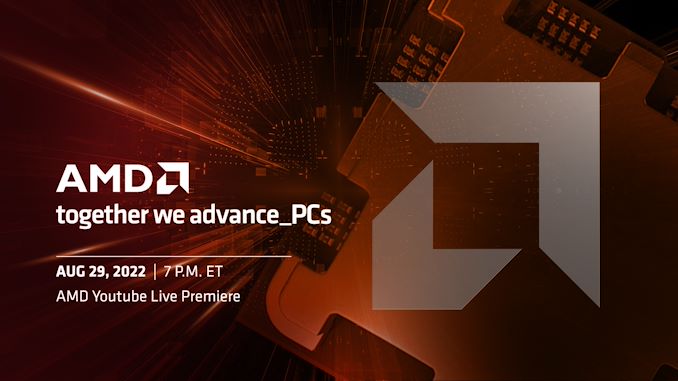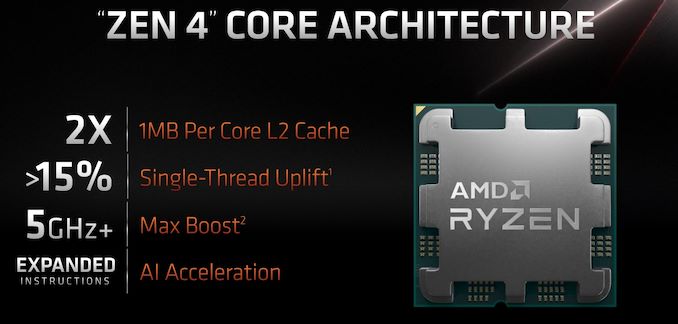AMD Announces Ryzen 7000 Reveal Livestream for August 29th
by Ryan Smith on August 16, 2022 2:25 PM EST- Posted in
- CPUs
- AMD
- Zen 4
- AM5
- Ryzen 7000

In a brief press release sent out this morning, AMD has announced that they will be delivering their eagerly anticipated Ryzen 7000 unveiling later this month as a live stream. In an event dubbed “together we advance_PCs”, AMD will be discussing the forthcoming Ryzen 7000 series processors as well as the underlying Zen 4 architecture and associated AM5 platform – laying the groundwork ahead of AMD’s planned fall launch for the Ryzen 7000 platform. The event is set to kick off on August 29th at 7pm ET (23:00 UTC), with CEO Dr. Lisa Su and CTO Mark Papermaster slated to present.
AMD first unveiled their Ryzen 7000 platform and branding back at Computex 2022, offering quite a few high-level details on the forthcoming consumer processor platform while stating it would be launching in the fall. The new CPU family will feature up to 16 Zen 4 cores using TSMC's optimized 5 nm manufacturing process for the Core Complex Die (CCD), and TSMC’s 6nm process for the I/O Die (IOD). AMD has not disclosed a great deal about the Zen 4 architecture itself, though their Computex presentation has indicated we should expect a several percent increase in IPC, along with a further several percent increase in peak clockspeeds, allowing for a 15%+ increase in single-threaded performance.
The Ryzen 7000 series is also notable for being the first of AMD’s chiplet-based CPUs to integrate a GPU – in this case embedding it in the IOD. The modest GPU allows for AMD’s CPUs to supply their own graphics, eliminating the need for a discrete GPU just to boot a system while, we expect, providing enough performance for basic desktop work.
| AMD Desktop CPU Generations | |||
| AnandTech | Ryzen 7000 (Raphael) |
Ryzen 5000 (Vermeer) |
Ryzen 3000 (Matisse) |
| CPU Architecture | Zen 4 | Zen 3 | Zen 2 |
| CPU Cores | Up To 16C / 32T | Up To 16C / 32T | Up To 16C / 32T |
| GPU Architecture | RDNA2 | N/A | N/A |
| GPU Cores | TBD | N/A | N/A |
| Memory | DDR5 | DDR4 | DDR4 |
| Platform | AM5 | AM4 | AM4 |
| CPU PCIe Lanes | 24x PCIe 5.0 | 24x PCIe 4.0 | 24x PCIe 4.0 |
| Manufacturing Process | CCD: TSMC N5 IOD: TSMC N6 |
CCD: TSMC N7 IOD: GloFo 12nm |
CCD: TSMC N7 IOD: GloFo 12nm |
The new CPU family will also come with a new socket and motherboard platform, which AMD is dubbing AM5. The first significant socket update for AMD in six years will bring with it a slew of changes and new features, including a switch to an LGA-style socket (LGA1718) and support for DDR5 memory. Providing the back-end for AM5 will be AMD’s 600 series chipsets, with AMD set to release both enthusiast and mainstream chipsets. PCIe 5.0 will also be supported by the platform, but in the interest of keeping motherboard prices in check, it is not a mandatory motherboard feature.
The remaining major disclosures that AMD hasn’t made – and which we’re expecting to see at their next event – will be around the Zen 4 architecture itself, as well as information on specific Ryzen 7000 SKUs. Pricing information is likely not in the cards (the industry has developed a strong tendency to announce prices at the last minute), but at the very least we should have an idea of how many cores to expect on the various SKUs, as well as where the official TDPs will land in this generation given AM5’s greater power limits.
Meanwhile, AMD’s press release does not mention whether the presentation will be recorded or live. Like most tech companies, AMD switched to pre-recorded presentations due to the outbreak of COVID-19, which in turn has been paying dividends in the form of breezier and more focused presentations with higher production values. While relatively insignificant in the big picture of things, it will be interesting to see whether AMD is going back to live presentations for consumer product unveils such as this.
In any case, we’ll find out more during AMD’s broadcast. The presentation is slated to air on August 29th at 7pm Eastern, on AMD’s YouTube channel. And of course, be sure to check out AnandTech for a full rundown and analysis of AMD’s announcements.
Source: AMD











52 Comments
View All Comments
spamaway - Friday, August 19, 2022 - link
10gtek sells 10GBase-SR SFPs for ~16 USD per, and are usually less than that if you buy two, five, or ten at a time.Unless you insist on 10GBase-T, decent SFP+ modules are cheap. (OM3 or OM4 fiber is pretty cheap, too.)
Qasar - Friday, August 19, 2022 - link
10gtek ?? never heard of them either.10g sfp+ modules are $60, and rj45 10g is $100
at least here, 10g is still too expensive. ive been looking at getting a gigabit switch that supports LACP properly for now. the one i have doesnt seem to support link aggregation fully
schujj07 - Wednesday, August 17, 2022 - link
1GbE is plenty fast for home user management/Internet. The only place in the home that 1GbE becomes a problem is if you have a NAS and need to retrieve a large amount of data. If all you do is use your NAS for say streaming 4k movies a 1GbE connection is plenty.abufrejoval - Wednesday, August 17, 2022 - link
I find this attitude both infuriating and condescending!The whole x86 server ecosystem depended on the tenet, that desktop hardware could be reused for servers, undercutting and ultimately killing near everything Unix and RISC.
And it's just what I want to continue to exploit.
So I build HCI clusters of x86 systems using RAIDs, SSDs and now NVMe and Gbit Ethernet just isn't a match to more than a single drive of spinning rust.
The network fabric needs to match the bandwidth of your storage at least, and width CXL it moves to the bandwidth of RAM.
10Gbit Ethernet is already far too slow, vis-à-vis 20Gbit USB 3.2 or 40 Gbits Thunderbolt 3.
schujj07 - Thursday, August 18, 2022 - link
99% of people are fine with GbE. You are not a typical use case. You could look into getting some 56Gb Mellanox ConnectX-3 NICs on ebay and a used switch for it. Lots of enterprises are getting rid of their 10/40 setups and going 25/100 or faster. The old stuff you can get at a good price.erotomania - Thursday, August 25, 2022 - link
No. Just no.ZoZo - Wednesday, August 17, 2022 - link
Intel's latest desktop chips come with a built-in Ethernet controller. They still require a separate controller such as the I225-V.ZoZo - Wednesday, August 17, 2022 - link
I meant, they *don't* come with one. (is there really no editing comments here?)ballsystemlord - Wednesday, August 17, 2022 - link
No editing for any of us. It's actually the only bad thing about AT's comment section.Flunk - Wednesday, August 17, 2022 - link
No Ethernet on chip.